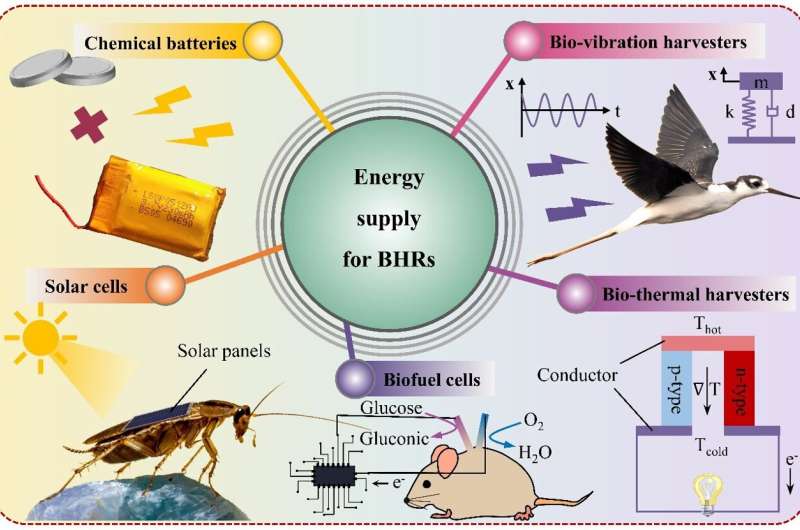A review of energy supply for biomachine hybrid robots

Bio-machine hybrid robots (BHRs) represent a new generation of micro-aerial vehicles that be controlled by building an interface between biological and artificial systems. In contrast to conventional bionic robots, they are free of complex mechanical structures, and due to the direct adoption of the animal body, they have superior movement characteristics and lower energy demand. Thus, BHRs can be applied in many important scenarios, such as urban and wilderness rescue operations, environmental monitoring and hazardous area surveys.
To accomplish long mission endurance, the energy supply of the control backpack must be considered. As different biological carriers have different requirements for the energy equipment, BHRs’ power supply is an important issue. A review paper by scientists at the Beijing Institute of Technology summarized advancements in supply devices in BHRs research.
The new review paper, published in the journal Cyborg and Bionic Systems, provided a comprehensive overview of the various energy supply methods in BHRs research, from the selection of chemical batteries for different bio-carriers to the development and application of various energy harvesters.
“You maybe couldn’t imagine that one day when you are trapped in the wild, the first one to notice your distress message and rescue you would be an animal. But this will be a reality in the future,” explained study author Jieliang Zhao, a professor at the Beijing Institute of Technology.
For a long time, bionic scientists have expected to be able to mimic nature’s biological constructions. Although scientists have designed and built robots to mimic the movement of animals in nature in every way possible, no bionic robot has yet matched the efficiency and maneuverability of the animal body itself.
Bio-machine hybrid robots (BHRs) have become another new method. BHRs use animals as carriers and modulate carrier movement by constructing bio-mechanical interfaces to accomplish scenario-specific tasks. The energy supply unit used to power the control backpack and electronic component carried by BHRs determines their future development and practical application, according to Zhao.
The newly published review analyzed the various energy supply methods in BHRs research. The study authors grouped the energy supply devices into five categories: chemical batteries; solar cells; biofuel cells; bio-thermal harvesters and bio-vibration harvesters. They analyzed the focus of different carrier animals in the selection of chemical batteries separately. For example, when selecting the battery for flying insects, in addition to meeting the basic electrical requirements, it is also necessary to consider the weight and size of the entire battery, to ensure the carrier insect can fly properly.
Although the size of the batteries is always decreasing, smaller batteries can’t provide sustainable energy for BHRs and frequent charging will affect animal life. Thus, some researchers started to develop solar cells, biofuel cells, bio-thermal harvesters and bio-vibration energy harvesters to supply energy to BHRs.
In the review, they team provides a summary overview of current research on self-powered devices for BHRs. “Energy harvesters can effectively harvest different forms of energy from the surrounding environment or the animal itself, which could achieve self-powering of the BHRs,” said Zhao.
Looking forward, the team considers that five important challenges need to be overcome. The first one is developing high energy density energy supply devices. They think with the creation of new materials and advances in micro/nano technology, the main directions for enhancing energy density are provided in terms of composite materials and micro-scale structural design.
The second consideration is developing biocompatibility of energy supply devices to avoid serious immune reactions that could affect the animal’s lifespan. The third issue is compound energy supply. By reasonably harvesting multiple environmental energy sources and applying multiple energy conversion mechanisms, the space utilization efficiency of energy supply devices can be improved effectively and the power output can be also increased.
The fourth consideration is the stability of the energy supply because the long-term stability of the energy supply system is a basic requirement for the effective control of BHRs. The last consideration is an environmentally friendly energy supply. As BHRs are used in the natural environment, addressing the impact of energy supply systems on the environment is a vital challenge.
“The research field of energy supply for BHRs is still in its infancy,” said Zhao. Most studies have been done only in the laboratory and the output of harvesters is lower than actual demand. As new conceptual robots, BHRs have important application prospects in future scenarios, such as animal monitoring and wildlife rescue.
The energy supply system directly determines the practical application of BHRs. This review calls for more researchers to be able to focus on this field and work together to overcome the challenges in energy supply and promote the practical application of BHRs.
More information:
Zhiyun Ma et al, A Review of Energy Supply for Biomachine Hybrid Robots, Cyborg and Bionic Systems (2023). DOI: 10.34133/cbsystems.0053
Provided by
Beijing Institute of Technology Press Co., Ltd
Citation:
A review of energy supply for biomachine hybrid robots (2023, October 20)
retrieved 21 October 2023
from https://techxplore.com/news/2023-10-energy-biomachine-hybrid-robots.html
This document is subject to copyright. Apart from any fair dealing for the purpose of private study or research, no
part may be reproduced without the written permission. The content is provided for information purposes only.
For all the latest Technology News Click Here
For the latest news and updates, follow us on Google News.

